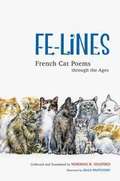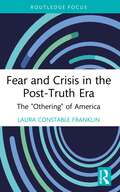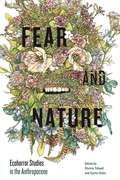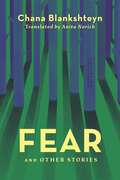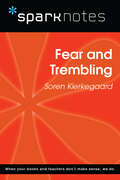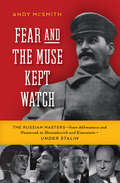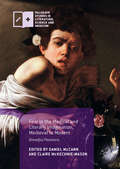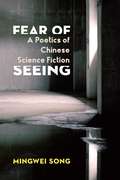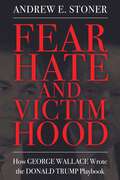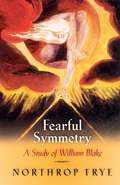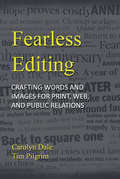- Table View
- List View
Fe-Lines: French Cat Poems through the Ages
by Norman R Shapiro Olga PastuchivThe French have long had a love affair with the cat, expressed through centuries of poetry portraying the animal's wit and wonder. Norman R. Shapiro lionizes the felines' limitless allure in this one-of-a-kind collection. Spanning centuries and styles, he draws on she-cats and toms, and an honor roll of French poets, well known and lesser known, who have served as their devoted champions. He reveals the remarkable range of French cat poems, with most works presented here for the first time in English translation. Scrupulously devoted to evoking the meaning and music of the originals, Shapiro also respects the works' formal structures. Pairing his translations with Olga Pastuchiv's elegant illustrations, Fe-Lines guides the reader through the marvels and inscrutabilities of the Mystique féline .
Fear and Crisis in the Post-Truth Era: The "Othering" of America (Routledge Focus on Communication Studies)
by Laura Constable FranklinThis book explores how political crisis talk, even false, can thread its way into the media and impact public opinion, legislation, and everyday lives.Grounded in theory and supported by data, it illustrates the powerful presence of the media in the public sphere and argues for a different approach toward the reiteration of misrepresentations and lies. Three case studies explore the strategic use of “othering” in the 21st century: The false depiction of Sharia and passage of anti-Sharia legislation in Tennessee; the anti-Muslim Congressional hearings sponsored by Rep. Peter King; and charges of Mexican criminality espoused by former President Donald Trump. A fourth case study illustrates the versatility of this mode of rhetoric through a thematic comparison of two nationalist speeches delivered years apart in vastly different settings. Findings suggest that many of the themes and tactics used in nationalist discourse remain startingly consistent. The reporting of false or overblown claims by the media often legitimized untruths, leading to additional repetition and exposure. Finally, it looks ahead, raising awareness of “othering” efforts with new minorities and the overall societal impact of demonization.For students and scholars exploring the tactics of nationalism and the power of mediatization, this book offers a dynamic, timely analysis of the effects that “othering” and false depictions have on innocent lives and the role that our most well-respected media outlets have played in the process.
Fear and Nature: Ecohorror Studies in the Anthropocene (AnthropoScene)
by Christy Tidwell Carter SolesEcohorror represents human fears about the natural world—killer plants and animals, catastrophic weather events, and disquieting encounters with the nonhuman. Its portrayals of animals, the environment, and even scientists build on popular conceptions of zoology, ecology, and the scientific process. As such, ecohorror is a genre uniquely situated to address life, art, and the dangers of scientific knowledge in the Anthropocene.Featuring new readings of the genre, Fear and Nature brings ecohorror texts and theories into conversation with other critical discourses. The chapters cover a variety of media forms, from literature and short fiction to manga, poetry, television, and film. The chronological range is equally varied, beginning in the nineteenth century with the work of Edgar Allan Poe and finishing in the twenty-first with Stephen King and Guillermo del Toro. This range highlights the significance of ecohorror as a mode. In their analyses, the contributors make explicit connections across chapters, question the limits of the genre, and address the ways in which our fears about nature intersect with those we hold about the racial, animal, and bodily “other.”A foundational text, this volume will appeal to specialists in horror studies, Gothic studies, the environmental humanities, and ecocriticism.In addition to the editors, the contributors include Kristen Angierski, Bridgitte Barclay, Marisol Cortez, Chelsea Davis, Joseph K. Heumann, Dawn Keetley, Ashley Kniss, Robin L. Murray, Brittany R. Roberts, Sharon Sharp, and Keri Stevenson.
Fear and Nature: Ecohorror Studies in the Anthropocene (AnthropoScene: The SLSA Book Series #8)
by Christy Tidwell Carter SolesEcohorror represents human fears about the natural world—killer plants and animals, catastrophic weather events, and disquieting encounters with the nonhuman. Its portrayals of animals, the environment, and even scientists build on popular conceptions of zoology, ecology, and the scientific process. As such, ecohorror is a genre uniquely situated to address life, art, and the dangers of scientific knowledge in the Anthropocene.Featuring new readings of the genre, Fear and Nature brings ecohorror texts and theories into conversation with other critical discourses. The chapters cover a variety of media forms, from literature and short fiction to manga, poetry, television, and film. The chronological range is equally varied, beginning in the nineteenth century with the work of Edgar Allan Poe and finishing in the twenty-first with Stephen King and Guillermo del Toro. This range highlights the significance of ecohorror as a mode. In their analyses, the contributors make explicit connections across chapters, question the limits of the genre, and address the ways in which our fears about nature intersect with those we hold about the racial, animal, and bodily "other."A foundational text, this volume will appeal to specialists in horror studies, Gothic studies, the environmental humanities, and ecocriticism.In addition to the editors, the contributors include Kristen Angierski, Bridgitte Barclay, Marisol Cortez, Chelsea Davis, Joseph K. Heumann, Dawn Keetley, Ashley Kniss, Robin L. Murray, Brittany R. Roberts, Sharon Sharp, and Keri Stevenson.
Fear and Other Stories
by Chana BlankshteynFear and Other Storiesis a translation from Yiddish to English of the collected stories of Chana Blankshteyn (~1860–1939), a woman who may be almost entirely forgotten now but was widely admired during her long and productive life. The mere existence of these stories is itself a remarkable feat as the collection was published in July 1939, just before the Nazis invaded Poland and two weeks before Blankshteyn’s death. Anita Norich’s introduction argues that this is not a work of Holocaust literature (there are no death camps, partisans or survivors of WWII), but anti-Semitism is palpable, as is the threat of war and its aftermath. What could it have felt like to live under these conditions? How might a woman who was a feminist, a Jew, and an activist understand the recent past of war and revolution through which she had lived and also confront the horror that was beginning to unfold? The nine stories in this volume take place primarily in Vilna, as well as various parts of Europe. As if presaging what was to come, World War I and Russian civil wars are the backdrops to these stories, as Jews and non-Jews find themselves under German occupation or caught up in the revolutionary fervor that promised them much and took away almost everything. The young women in Blankshteyn’s stories insist on their independence, on equality with their lovers, and on meaningful work. Like the men in the stories, they study, work, and yearn for love. The situations in which these characters find themselves may be unfamiliar to a contemporary reader, but their reactions to the turmoil, the frighteningly changing times, and the desire for love and self-expression are deeply resonant with today’s audience. The history may be specific, but the emotions are universal. Blankshteyn’s stories are both a view of the final gasp of Eastern European Jewish culture and a compelling modern perspective on the broader world. Students and scholars of history and culture, women’s literature, and translation studies will wonder how they’ve gone this long without reading Blankshteyn’s work.
Fear and Trembling (SparkNotes Philosophy Guide)
by SparkNotesFear and Trembling (SparkNotes Philosophy Guide) Making the reading experience fun! SparkNotes Philosophy Guides are one-stop guides to the great works of philosophy–masterpieces that stand at the foundations of Western thought. Inside each Philosophy Guide you&’ll find insightful overviews of great philosophical works of the Western world.
Fear and the Muse Kept Watch
by Andy McsmithIn this dazzling exploration of one of the most contradictory periods of literary and artistic achievement in modern history, journalist Andy McSmith evokes the lives of more than a dozen of the most brilliant artists and writers of the twentieth century. Taking us deep into Stalin’s Russia, Fear and the Muse Kept Watch asks the question: can great art be produced in a police state? For although Josif Stalin ran one of the most oppressive regimes in world history, under him Russia also produced an outpouring of artistic works of immense and lasting power--from the poems of Anna Akhmatova and Osip Mandelstam to the opera Peter and the Wolf, the film Alexander Nevsky, and the novels The Master and Margarita and Doctor Zhivago. For those artists visible enough for Stalin to take an interest in them, it was Stalin himself who decided whether they lived in luxury or were sent to the Lubyanka, the headquarters of the secret police, to be tortured and sometimes even executed. McSmith brings together the stories of these artists--including Isaac Babel, Boris Pasternak, Dmitri Shostakovich, and many others--revealing how they pursued their art under Stalin’s regime and often at great personal risk. It was a world in which the poet Vladimir Mayakovsky, whose bright yellow tunic was considered a threat to public order under the tsars, struggled to make the communist authorities see the value of avant garde art; Babel publicly thanked the regime for allowing him the privilege of not writing; and Shostakovich’s career veered wildly between public disgrace and wealth and acclaim. In the tradition of Eileen Simpson’s Poets in Their Youth and Phyllis Rose’s Parallel Lives, Fear and the Muse Kept Watch is an extraordinary work of historical recovery. It is also a bold exploration of the triumph of art during terrible times and a book that will stay with its readers for a long, long while.
Fear in the Medical and Literary Imagination, Medieval to Modern: Dreadful Passions (Palgrave Studies in Literature, Science and Medicine)
by Daniel McCann Claire McKechnie-MasonThis book is about an emotion constantly present in human culture and history: fear. It is also a book about literature and medicine, two areas of human endeavour that engage with fear most acutely. The essays in this volume explore fear in various literary and medical manifestations, in the Western World, from medieval to modern times. It is divided into two parts. The first part, Treating Fear, examines fear in medical history, and draws from theology, medicine, philosophy, and psychology, to offer an account of how fear shifts in Western understanding from the Middle Ages to Modern times. The second part, Writing Fear, explores fear as a rhetorical and literary force, offering an account of how it is used and evoked in distinct literary periods and texts. This coherent and fascinating collection will appeal to medical historians, literary critics, cultural theorists, medical humanities’ scholars and historians of the emotions.
Fear of Seeing: A Poetics of Chinese Science Fiction (Global Chinese Culture)
by Mingwei SongA new wave of cutting-edge, risk-taking science fiction has energized twenty-first-century Chinese literature. These works capture the anticipation and anxieties of China’s new era, speaking to a future filled with uncertainties. Deeply entangled with the politics and culture of a changing China, contemporary science fiction has also attracted a growing global readership.Fear of Seeing traces the new wave’s origin and development over the past three decades, exploring the core concerns and literary strategies that make it so distinctive and vital. Mingwei Song argues that recent Chinese science fiction is united by a capacity to illuminate what had been invisible—what society had chosen not to see; what conventional literature had failed to represent. Its poetics of the invisible opens up new literary possibilities and inspires new ways of telling stories about China and the world. Reading the works of major writers such as Liu Cixin and Han Song as well as lesser-known figures, Song explores how science fiction has spurred larger changes in contemporary literature and culture. He analyzes key topics: variations of utopia and dystopia, cyborgs and the posthuman, and nonbinary perspectives on gender and genre, among many more. A compelling and authoritative account of the politics and poetics of contemporary Chinese science fiction, Fear of Seeing is an important book for all readers interested in the genre’s significance for twenty-first-century literature.
Fear, Hate, and Victimhood: How George Wallace Wrote the Donald Trump Playbook (Race, Rhetoric, and Media Series)
by Andrew E. StonerWhen Donald Trump announced his campaign for president in 2015, journalists, historians, and politicians alike attempted to compare his candidacy to that of Governor George Wallace. Like Trump, Wallace, who launched four presidential campaigns between 1964 and 1976, utilized rhetoric based in resentment, nationalism, and anger to sway and eventually captivate voters among America’s white majority. Though separated by almost half a century, the campaigns of both Wallace and Trump broke new grounds for political partisanship and divisiveness.In Fear, Hate, and Victimhood: How George Wallace Wrote the Donald Trump Playbook, author Andrew E. Stoner conducts a deep analysis of the two candidates, their campaigns, and their speeches and activities, as well as their coverage by the media, through the lens of demagogic rhetoric. Though past work on Wallace argues conventional politics overcame the candidate, Stoner makes the case that Wallace may in fact be a prelude to the more successful Trump campaign.Stoner considers how ideas about “in-group” and “out-group” mentalities operate in politics, how anti-establishment views permeate much of the rhetoric in question, and how expressions of victimhood often paradoxically characterize the language of a leader praised for “telling it like it is.” He also examines the role of political spectacle in each candidate’s campaigns, exploring how media struggles to respond to—let alone document—demagogic rhetoric.Ultimately, the author suggests that the Trump presidency can be understood as an actualized version of the Wallace presidency that never was. Though vast differences exist, the demagogic positioning of both men provides a framework to dissect these times—and perhaps a valuable warning about what is possible in our highly digitized information society.
Fearful Symmetry: A Study of William Blake
by Northrop FryeThis brilliant outline of Blake's thought and commentary on his poetry comes on the crest of the current interest in Blake, and carries us further towards an understanding of his work than any previous study. Here is a dear and complete solution to the riddles of the longer poems, the so-called "Prophecies," and a demonstration of Blake's insight that will amaze the modern reader. The first section of the book shows how Blake arrived at a theory of knowledge that was also, for him, a theory of religion, of human life and of art, and how this rigorously defined system of ideas found expression in the complicated but consistent symbolism of his poetry. The second and third parts, after indicating the relation of Blake to English literature and the intellectual atmosphere of his own time, explain the meaning of Blake's poems and the significance of their characters.
Fearful Symmetry: A Study of William Blake
by Northrop FryeThe landmark book that situates Blake&’s poetry within the intellectual movements of his day and unlocks his symbolism for modern readersSince it was first published, Northrop Frye&’s Fearful Symmetry has established itself as the defining commentary on the poetic vision of William Blake. Frye gives a complete solution to the riddles of Blake&’s longer poems—the so-called &“Prophecies&”—and demonstrates how Blake&’s works form a coherent mythical pattern that broadens our conception of literature. He explains how Blake arrived at a theory of knowledge that was also, for him, a theory of religion, life, and art, and how this rigorously defined system of ideas found expression in the complicated but consistent symbolism of his poetry. With an incisive foreword by scholar and literary critic Nicholas Halmi, this Princeton Classics edition shows how Blake reflects the literary and the intellectual atmosphere of his time while holding renewed meaning for us today.
Fearless Editing: Crafting Words and Images for Print, Web, and Public Relations
by Carolyn Dale Tim PilgrimFearless Editing clearly articulates the basic concepts underlying editing techniques and demonstrates their application for newspapers, public relations, magazines and Web pages. This text takes a conceptual approach that integrates verbal skills with visual elements. Unlike other texts that are clearly designed for print, this book includes multi-media applications in every chapter.
Fearless Public Speaking: A Guide for Beginners (SparkNotes)
by Joy JonesScared of speaking in public? You&’re not alone! This accessible guide, written by a former teacher and poetry slam coach, will help tweens and teens find their voice! If you have weak, wobbly knees and a pounding heart when you face an audience—don&’t worry, that&’s good! Joy Jones is here to show teens and tweens that stage fright is your friend. With its funny, friendly, slightly irreverent approach, Fearless Public Speaking helps young people feel more comfortable and confident in front of a crowd. Jones covers it all, from how to write and organize your speech, to how to deliver it and use audiovisual equipment, to how to troubleshoot when things go wrong.
Fearless Writing: How to Create Boldly and Write with Confidence
by William KenowerFind the courage to create your best writing life. Whether you're a fledgling writer or a veteran with years of experience, fearlessness--that elusive blend of self-acceptance, confidence, and curiosity--is the defining quality of those who find fulfillment and success. Truly fearless authors banish writer's blocks with ease, receive critiques gracefully, and infuse their passion for the craft into every word they write. Filled with insightful wisdom and practical advice, Fearless Writing teaches you how to thrive as a writer, no matter your genre or career path. You'll learn how to:Find and enter a Flow state in which writing is a natural, deeply satisfying process.Quiet both internal and external critics and embrace the inherent value in your work.Use love, emotional engagement, and curiosity as the guiding principles for what you write and how you share it with others.Overcome rejection, procrastination, and other obstacles that stifle your creativity.From the blank page to the first draft, and from querying to marketing, the writing life is filled with challenges, roadblocks, and new experiences. With Fearless Writing, you'll find the inner strength to embark on a bold journey--and build a lifelong career in the process.
Feast of Stephen
by Stephen Leacock“Do you know the characteristic wine of Madeira?…I do not know whether Leacock ever drank Madeira himself – he was very much a Scotch-whisky man – but I enjoy Madeira greatly, and I never drink it without thinking of Leacock, who was sometimes dry, sometimes sweet, but who always leaves upon the tongue a hint of brimstone…” In his witty and illuminating introduction, which takes up the first third of the book, Robertson Davies invites us to join him in a Feast of Stephen. Davies’ selection of fifteen pieces from Leacock’s less familiar works presents the humorist as a true, broad, and sympathetic interpreter of Canadian life, as a man who may have lacked self-knowledge and sensitive insight into the feelings of others, but “whose best work was the outpouring of genius.” All shades of Leacock’s writing are represented here, from the “brilliant nonsense which made some critics liken him to Lewis Carroll,” to his occasional attacks of “aggressive Lowbrowism.” Together in all their diversity, Davies’ selections pay tribute to the gifts of exuberance, originality, and slightly malicious truth with which Leacock so entertainingly extends our vision.
Feasting the Heart
by Reynolds PriceIn the fall of 1993, Alice Winkler of National Public Radio's "Morning Edition" asked Reynolds Price to write a short story for a Christmas morning broadcast. This assignment would result in NPR's inviting Price to join its varied group of commentators on "All Things Considered." The laws of radio require a concision that has become a welcome new discipline for Price; and here are all the personal essays which he has broadcast since July 25, 1995. Whether recounting events from his past, examining the details of his current experience as a writer, teacher, traveler, and general witness of the world, Price demonstrates in his direct prose that a writer can instantly connect with his audience. He discusses a few predictable topics -- family, the poisonous mysteries of racial intolerance, and faith -- but he also deals with new matters: capital punishment, Gone With the Wind, his adventures while navigating an immensely inaccessible America in a wheelchair; and he provides a memorable piece on childlessness. Throughout, Price never loses sight of the origin of either the word or the spirit of the essay -- the French word connotes a try, an attempt -- and each piece here is a well-formed, revealing, often amusing and refreshing foray into a moment unlike any we've encountered in other forms from him. We're unlikely to read more thought-provoking work from a commentator for a great time to come.
Feature Writing and Reporting: Journalism in the Digital Age
by Jennifer Brannock CoxThis new text offers a fresh look at feature writing and reporting in the 21st century. Award-winning professor and author Jennifer Brannock Cox teaches students the fundamentals of feature writing and reporting while emphasizing the skills and tools needed to be successful in the digital era. Packed with the best samples of feature writing today, this practical text gives students ample opportunity to practice their writing as they build a portfolio of work for their future careers. Cox′s special attention on new multimedia and online reporting prepares readers for success in a rapidly changing media landscape.
Feature Writing and Reporting: Journalism in the Digital Age
by Jennifer Brannock CoxThis new text offers a fresh look at feature writing and reporting in the 21st century. Award-winning professor and author Jennifer Brannock Cox teaches students the fundamentals of feature writing and reporting while emphasizing the skills and tools needed to be successful in the digital era. Packed with the best samples of feature writing today, this practical text gives students ample opportunity to practice their writing as they build a portfolio of work for their future careers. Cox′s special attention on new multimedia and online reporting prepares readers for success in a rapidly changing media landscape.
Feature Writing for Journalists (Media Skills)
by Sharon WheelerFeature Writing for Journalists considers both newspapers and magazines and helps the new or aspiring journalist to become a successful feature writer. Using examples from a wide range of papers, specialist and trade magazines and 'alternative' publications, Sharon Wheeler considers the different types of material that come under the term 'feature' including human interest pieces, restaurant reviews and advice columns. With relevant case studies as well as interviews with practitioners, Feature Writing for Journalists is exactly what you need to understand and create exciting and informative features.
Feature Writing for Newspapers and Magazines (5th edition)
by John Lee Edward Jay FriedlanderUsing experience-driven advice and compelling articles from scores of newspapers and magazines, Feature Writing for Newspapers and Magazines shows how award-winning journalists achieve excellence and national recognition. Feature Writing for Newspapers and Magazines' world-class writing examples, extensive updates and timely tips from some of America's best feature and magazine writer's have made it the premier text in its field for almost two decades. The book considers such topics as: what to do about common writing problems, how to develop, research, write about and sell ideas to periodicals, and how to negotiate writing contracts and write articles so that the journalist will not get into legal trouble.
Feature Writing: A Practical Introduction
by Susan Featherstone Susan PapeThis book provides a practical and richly informative introduction to feature writing and the broader context in which features journalists operate. As well as covering the key elements and distinctive features that constitute good feature writing, the book also offers a rich resource of real life examples, case studies and exercises. The authors have drawn on their considerable shared experience to provide a solid and engaging grounding in the principles and practice of feature writing. The textbook will explore the possibilities of feature writing, including essential basics, such as: Why journalists become feature writers The difference between news stories and features What features need to contain How to write features The different types of features The text is intended for both those who are studying the media at degree level and those who are wishing to embark on a career in the print industry. It will be invaluable for trainee feature writers.
Feature Writing: The Pursuit of Excellence
by John Lee Edward Jay FriedlanderUsing experience-driven advice and compelling articles from scores of newspaper, magazine and online writers, Feature Writing shows how award-winning journalists achieve excellence and national recognition. The Seventh Edition helps the reader cultivate vital journalistic skills through detailed coverage on creating and refining article ideas, conducting research and interviews, writing, and navigating legal and ethical questions. World-class writing examples from Pulitzer Prize feature writers, extensive updates, and timely tips from some of America's best feature writers have made this the premier book in its field for more than three decades.
Feature and Magazine Article Writing
by Janet E. RamseyJournalism textbook defining different types of articles and writings.
Feature and Magazine Writing
by Holly G. Miller David E. SumnerUpdated with fresh facts, examples and illustrations, along with two new chapters on digital media and blogs this third edition continues to be the authoritative and essential guide to writing engaging and marketable feature stories.Covers everything from finding original ideas and angles to locating expert sourcesExpanded edition with new chapters on storytelling for digital media and building a story blogCaptivating style exemplifies the authors' expert guidance, combining academic authority with professional know-howComprehensive coverage of all the angles, including marketing written work and finding jobs in the publishing industryEssential reading for anyone wishing to become a strong feature writerAccompanied by a website with a wealth of resources including PowerPoint presentations, handouts, and Q&As that will be available upon publication: www.wiley.com/go/sumnerandmiller
